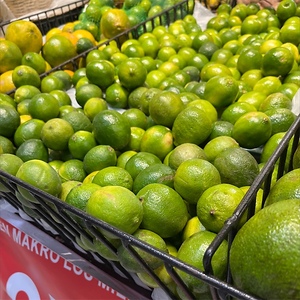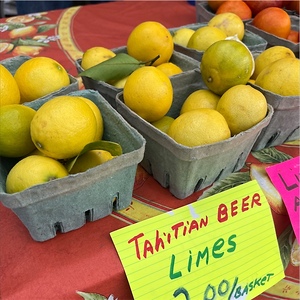


Tahiti Limes
Estimated Inventory, lb : 0
Description/Taste
Tahiti limes are large fruits, averaging 4 to 6 centimeters in diameter, and have a globular, oval, to ovate shape. The rind is smooth, firm, thin, and glossy, covered in small pores, and ripens from green to pale yellow when mature. Underneath the surface, the flesh is tightly attached to the rind and is aqueous, soft, pale green, and is divided into 8 to 10 segments by thin, white membranes. The flesh is also highly aromatic and seedless, or it may contain a few cream-colored seeds. Tahiti limes have an acidic, bright, and subtly sweet, green flavor.
Seasons/Availability
Tahiti limes are available year-round.
Current Facts
Tahiti limes, botanically classified as Citrus latifolia, are tart fruits belonging to the Rutaceae family. While the name Tahiti gives the fruits a tropical reputation, Tahiti limes, more commonly known as Persian limes or Bearss limes, are ancient fruits from Asia that have spread across the world through exploration, trade, and immigration. During the fruit’s global expansion, Tahiti limes earned their name after the lime’s introduction from Tahiti to California in the 1800s. Over time, Tahiti limes have become a favorite cultivar among growers and are one of the most commercially cultivated varieties in modern-day global markets. Tahiti limes are generally seedless, juicy, have extended storage capabilities, and exhibit adaptable growth characteristics. Among consumers, the fruits are favored for their tart and acidic flavor and are used in both culinary applications and mixology.
Nutritional Value
Tahiti limes are an excellent source of vitamin C, which is an antioxidant that can boost the immune system and increase collagen production within the body. The fruits are also a good source of dietary fiber, which can help regulate digestion and contain minerals like calcium, iron, potassium, copper, magnesium, and phosphorus. Both the rind and the pulp contain phytochemical polyphenols and terpenes, specifically limonene, which gives the fruit its citrusy aroma. The volatile oils extracted from the peel are used in aromatherapy, skin products, and perfumes.
Applications
Tahiti limes are best suited for fresh applications, and both the juice and zest are used to add bright, acidic flavors into dishes. The tart fruits are used in many different cuisines around the world as a natural tenderizer and marinade for meats, and they can be squeezed over any dish as a finishing flavor. Tahiti lime juice can also be used to flavor salsa and guacamole, doubling as an anti-browning agent for the avocado, and stirred into vinegar, dressings, and sauces for added acidity. The zest of the rind is commonly mixed with juice in baked goods, curries, soups, and stews, or it is used to flavor rice. In addition to culinary applications, Tahiti lime juice is commercially produced for limeade, juice concentrate, and is a key flavoring in cocktails. In the Middle East, Tahiti or Persian limes are popularly blanched in salt water and dried in the sun. This process transforms the fruits into a concentrated flavoring that can be stored for extended periods of time. Dried Tahiti limes can be crushed or ground into a powder and incorporated into stews, soups, and rice. Tahiti limes pair well with herbs such as cilantro, oregano, and thyme, coconut milk, cucumbers, tomatoes, cauliflower, kale, avocado, fava beans, spices such as turmeric, cumin, and curry powder, seafood, and meats such as pork, beef, poultry, and lamb. The fruits will keep 1-2 weeks when stored at room temperature and 3-4 weeks when stored in a plastic bag in the crisper drawer of the refrigerator.
Ethnic/Cultural Info
In Tahiti, limes are used in the national dish known as iaota, which is a unique meal that combines fresh fish with lime juice, coconut cream, and vegetables. Iaota is also known as poisson cru, which translates from French to mean “raw fish,” and the most popularly used fish in the dish is tuna. In addition to raw fish, ioata can be made with other seafood such as octopus, shrimp, crab, and sea urchin, and the dish is meant to highlight the fresh, local ingredients found on the island. Tahitians take great pride in iaota, and the dish can be widely found at high-end dining establishments to small food huts along the beach.
Geography/History
Tahiti limes are believed to be native to Asia in an area described as the Indo-Malayan region, which stretches from India to Southeastern Asia, including the Philippines, Malaysia, and Indonesia. While the exact origins of the variety are unknown, Tahiti limes were thought to have been brought to North Africa and the Eastern Mediterranean region through Persia the 10th century and to the Western Mediterranean region by crusaders during the 11th and 12th centuries. The lime continued to spread and was introduced to Brazil by Portuguese explorers, where it was then brought to Australia and Tahiti in the early 19th century. From Tahiti, the limes were introduced to California and Florida in the late 19th century, where they became widely cultivated in Florida orchards, replacing the Mexican lime. Today Tahiti limes are cultivated around the world and are commercially grown in Mexico, Florida, Brazil, regions of Central America, and Israel. The limes are widely available through supermarkets, specialty grocers, and farmer’s markets and are also a popular home garden variety.
Recipe Ideas
Recipes that include Tahiti Limes. One
| Ask Sarah |
|
Tahitian Lime Pie |









